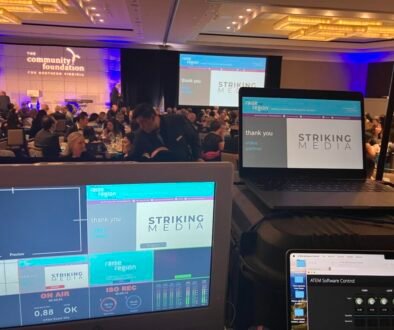Storytelling Videography
Production companies can use actors in nonprofit storytelling videography to bring a narrative to life, in instances where ‘real people’ cannot feature. Striking Media discusses how to make this work for the best possible result.
Creating engaging videos with actors is a key part of video production – but one that many shy away from. Whether for film, TV, commercials, or digital content, actors breathe life into scripts, helping to convey emotions, ideas, and narratives in ways that resonate with audiences through your storytelling videography. If you’re producing videos and considering using actors in your projects, here are a few key points to consider for a successful production:
1. Casting the Right Talent
Finding the right actor can make or break your production. Casting is about matching the actor’s look, experience, and acting style to the role. Some tips for effective casting:
- Auditions: Host multiple rounds of auditions to see actors’ range and flexibility. Don’t just settle on the first good audition—explore your options. Have the talent read your script, they may be really good at portraying one emotion, less good at portraying another.
- Chemistry: If your production involves multiple actors, check their chemistry during casting. An actor might be great on their own but may not mesh well with the rest of the cast.
- Typecasting: Avoid falling into the trap of typecasting. While some actors might excel in a specific type of role, consider how they could bring new dimensions to a different character.
- Logistics: Ensure your actor is willing to be a team player. Nobody wants attitude on a set and filming often runs longer than expected or variables are thrown in. It is preferable to have team players on board.
2. Collaboration with Actors
Directors should work closely with actors to ensure the best performance. A collaborative environment helps actors feel comfortable experimenting with their roles in storytelling videography.
- Give Direction, Not Orders: Provide clear direction that comes from one person on set, not multiple, but give actors room to bring their interpretation to the character. A balance between guidance and creative freedom is key.
- Rehearsals: Spend time in rehearsals so the actors can become familiar with each other and the script, and they can make adjustments before filming.
- Character Development: Work with actors to deeply understand their characters’ backstories, motivations, and nuances. This will lead to more authentic performances.
3. Working with Actors on Set
On the actual shoot day, it’s essential to create a comfortable and productive environment for the actors to perform.
- Set Atmosphere: A positive and professional atmosphere allows actors to focus. Keep the set organized, and minimize distractions so actors can stay in character.
- Plan Plan Plan: Create generous call times giving sufficient time for everyone to arrive, despite traffic delays, grab a coffee, get to hair and make up. A rushed schedule works for no one! As this article shows nothing about casting actors should be rushed, as actors can make or break your production! https://www.openlightfilms.com/how-to-cast-actors-for-video-production
- Communication: Open communication is key to ensure that any issues, from technical problems to performance tweaks, are addressed smoothly.
- Pacing and Breaks: Long shoots can be exhausting, so it’s important to manage time well and give actors adequate breaks to maintain energy and focus. Ensure sufficient catering is provided, sometimes you just need sugar!
Striking Media had great success with a team of talented actors on a shoot for OAR (Offenders Action Restoration) You can see the result here.
4. Improvisation
While a well-written script is important, allowing room for improvisation can lead to unexpected, yet brilliant moments in your production.
- Trust in Actors: If the actor truly understands their character, trust them to improvise lines or reactions that may feel natural to the scene.
- Controlled Improvisation: Establish boundaries for improvisation to keep the scene’s focus intact, but allow actors the creative freedom to explore their roles.
6. Marketing and Distribution with Actors
Having actors involved in marketing your video can boost its appeal, especially if they have a following.
- Behind the Scenes (BTS) Footage: Share BTS content that features actors in casual settings or during rehearsals. This builds excitement and humanizes your production.
- Social Media Collaborations: Encourage actors to share the video or production updates on their social media channels. This can significantly increase your video’s reach.
- Expand your network: Actors appreciate seeing their work come to life, so always share the final result and get them to tag you when they share the storytelling videography!
Conclusion
Actors are essential collaborators in storytelling videography. By focusing on casting, fostering strong working relationships, encouraging improvisation, and involving actors in the post-production and marketing phases, your production will not only be of high quality but also resonate more deeply with audiences. A thoughtful, actor-centered approach ensures that every performance is authentic and memorable.




